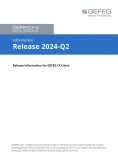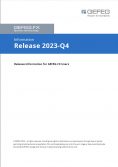Now also develop JSON schema guides with GEFEG.FX – New functions in the JSON schema editor
Enhancement for the development of JSON schemas for EDI and business data management: You can now also create JSON schema guides with GEFEG.FX. This means that the proven guide technology is now also available for JSON schemas.
Read more: New JSON schema guide functions – More flexibility and quality for EDI
What else is new in the GEFEG.FX 2024-Q2 release?
With the new GEFEG.FX quarterly release 2024-Q2, the following new or enhanced functionalities are also available for use.
Assign file names automatically in the publishing project, as of now in the current release
The new version of GEFEG.FX allows you to automatically assign file names when creating documentation, whereas previously each new file name had to be defined manually. From now on, GEFEG.FX automatically uses the names of the GEFEG.FX objects as aliases for the documentation files that you want to create.
The new process saves time and eliminates potential sources of error, as manual naming per documentation file is no longer necessary.
ISO 20022 schema exports from data models is now easier
More and more B2B standards are being published as syntax-neutral data models, including the ISO 20022 data model for the financial industry. The use of data models with GEFEG.FX has the unique advantage that company-specific GEFEG.FX guidelines can be created on the basis of the data models. In these guides, users describe the requirements of their company, such as the restriction of elements.
XML schema formats generated from the data model or data model guideline are used for data exchange in production systems. The smooth, automatic flow of data from the data model to the schema is therefore an important prerequisite for successful data exchange.
Previously, a GEFEG.FX schema had to be created manually in an intermediate step and then exported as an XSD file. This process has been optimised – from the data model to the GEFEG.FX schema! Now you can export the XML schema directly from a data model via publishing projects with a single click.
Improved conversion of continuous text in Microsoft Word documents for PDF documents
GEFEG.FX enables you to document data structures simply and efficiently. Many users use Microsoft Word to present their data clearly with additional information. With the Word file format, the user data is clearly presented together with supplementary information and provides a clear insight into the structure and properties of your data.
The output of these Word documents as PDF files has now been improved. If you now create documentation with GEFEG.FX publishing projects, plain text is now generated in all Notes with text content, line breaks in continuous text are omitted. This eliminates potential sources of error and simplifies the subsequent work steps with the aim of generating a PDF file as the documentation result.
Improved guide comparison display
The guide comparison shows differences between two comparison objects in a comparison list below the two data structures. As we have noticed in support cases that the display is not always easy to understand, this view has been streamlined and new categories have been added to help users recognise differences more quickly and understand them better. This makes it easier to understand the differences between the data structures.
Data packages in GEFEG.FX
The following new, supplemented or modified data packages are available for download
- UN/EDIFACT: Version D.23B will not be available in accordance with the UN/CEFACT decision, as no change requests and therefore no changes have been submitted
- UN/Locode, Status as of 2023-2
- GS1 EANCOM® Application Guidelines: Fashion 2.1 added
- ISO20022: Version 2024 of the e-Repository is available.
- Odette Recommendations: An updated version is available
- VDA Recommendations: An updated version is available
- xCBL 3.0 + 3.5: Elements now also contain descriptions
- DK Guideline Schemas V3.7 (Deutsche Kreditwirtschaft)

